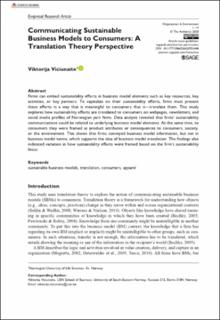| dc.contributor.author | Viciunaite, Viktorija | |
| dc.date.accessioned | 2021-05-26T11:38:51Z | |
| dc.date.available | 2021-05-26T11:38:51Z | |
| dc.date.created | 2020-09-25T12:51:04Z | |
| dc.date.issued | 2020 | |
| dc.identifier.citation | Organization & Environment. 2020, 1-19. | |
| dc.identifier.issn | 1086-0266 | |
| dc.identifier.uri | https://hdl.handle.net/11250/2756440 | |
| dc.description.abstract | Firms can embed sustainability efforts in business model elements such as key resources, key activities, or key partners. To capitalize on their sustainability efforts, firms must present these efforts in a way that is meaningful to consumers that is—translate them. This study explores how sustainability efforts are translated to consumers on webpages, newsletters, and social media profiles of Norwegian yarn firms. Data analysis revealed that firms’ sustainability communications could be related to underlying business model elements. At the same time, to consumers they were framed as product attributes or consequences to consumers, society, or the environment. This shows that firms conveyed business model information, but not in business model terms, which supports the idea of business model translation. The findings also indicated variation in how sustainability efforts were framed based on the firm’s sustainability focus. | |
| dc.language.iso | eng | |
| dc.relation.uri | https://journals.sagepub.com/doi/10.1177/1086026620953448 | |
| dc.title | Communicating Sustainable Business Models to Consumers: A Translation Theory Perspective | |
| dc.type | Peer reviewed | |
| dc.type | Journal article | |
| dc.description.version | publishedVersion | |
| dc.source.pagenumber | 1-19 | |
| dc.source.journal | Organization & Environment | |
| dc.identifier.doi | 10.1177/1086026620953448 | |
| dc.identifier.cristin | 1833434 | |
| dc.relation.project | Norges forskningsråd: 244618 | |
| cristin.ispublished | true | |
| cristin.fulltext | original | |
| cristin.qualitycode | 1 | |
